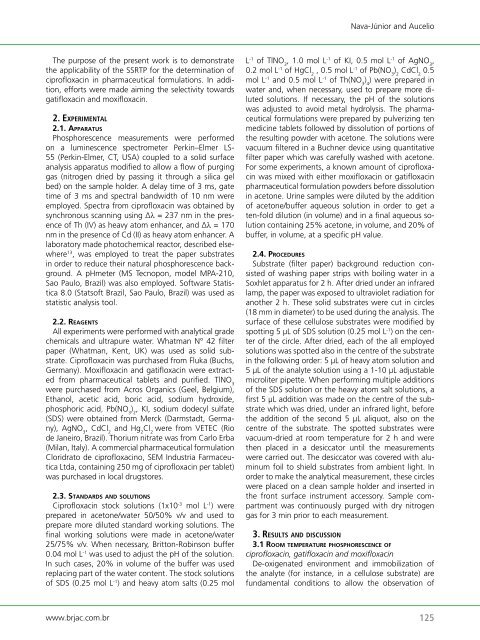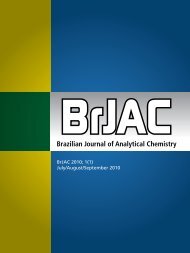Brazilian Journal of Analytical Chemistry - BRJAC - Brazilian Journal ...
Brazilian Journal of Analytical Chemistry - BRJAC - Brazilian Journal ...
Brazilian Journal of Analytical Chemistry - BRJAC - Brazilian Journal ...
You also want an ePaper? Increase the reach of your titles
YUMPU automatically turns print PDFs into web optimized ePapers that Google loves.
The purpose <strong>of</strong> the present work is to demonstrate<br />
the applicability <strong>of</strong> the SSRTP for the determination <strong>of</strong><br />
cipr<strong>of</strong>loxacin in pharmaceutical formulations. In addition,<br />
efforts were made aiming the selectivity towards<br />
gatifloxacin and moxifloxacin.<br />
2. ExPErimEntal<br />
2.1. ap p a r a t u s<br />
Phosphorescence measurements were performed<br />
on a luminescence spectrometer Perkin–Elmer LS-<br />
55 (Perkin-Elmer, CT, USA) coupled to a solid surface<br />
analysis apparatus modified to allow a flow <strong>of</strong> purging<br />
gas (nitrogen dried by passing it through a silica gel<br />
bed) on the sample holder. A delay time <strong>of</strong> 3 ms, gate<br />
time <strong>of</strong> 3 ms and spectral bandwidth <strong>of</strong> 10 nm were<br />
employed. Spectra from cipr<strong>of</strong>loxacin was obtained by<br />
synchronous scanning using Δλ = 237 nm in the presence<br />
<strong>of</strong> Th (IV) as heavy atom enhancer, and Δλ = 170<br />
nm in the presence <strong>of</strong> Cd (II) as heavy atom enhancer. A<br />
laboratory made photochemical reactor, described elsewhere<br />
13 , was employed to treat the paper substrates<br />
in order to reduce their natural phosphorescence background.<br />
A pHmeter (MS Tecnopon, model MPA-210,<br />
Sao Paulo, Brazil) was also employed. S<strong>of</strong>tware Statistica<br />
8.0 (Stats<strong>of</strong>t Brazil, Sao Paulo, Brazil) was used as<br />
statistic analysis tool.<br />
2.2. re a g e n t s<br />
All experiments were performed with analytical grade<br />
chemicals and ultrapure water. Whatman N° 42 filter<br />
paper (Whatman, Kent, UK) was used as solid substrate.<br />
Cipr<strong>of</strong>loxacin was purchased from Fluka (Buchs,<br />
Germany). Moxifloxacin and gatifloxacin were extracted<br />
from pharmaceutical tablets and purified. TlNO 3<br />
were purchased from Acros Organics (Geel, Belgium),<br />
Ethanol, acetic acid, boric acid, sodium hydroxide,<br />
phosphoric acid, Pb(NO 3 ) 2 , KI, sodium dodecyl sulfate<br />
(SDS) were obtained from Merck (Darmstadt, Germany),<br />
AgNO 3 , CdCl 2 and Hg 2 Cl 2 were from VETEC (Rio<br />
de Janeiro, Brazil). Thorium nitrate was from Carlo Erba<br />
(Milan, Italy). A commercial pharmaceutical formulation<br />
Cloridrato de cipr<strong>of</strong>loxacino, SEM Industria Farmaceutica<br />
Ltda, containing 250 mg <strong>of</strong> cipr<strong>of</strong>loxacin per tablet)<br />
was purchased in local drugstores.<br />
2.3. st a n d a r d s a n d s o l u t Io n s<br />
Cipr<strong>of</strong>loxacin stock solutions (1x10 -3 mol L -1 ) were<br />
prepared in acetone/water 50/50% v/v and used to<br />
prepare more diluted standard working solutions. The<br />
final working solutions were made in acetone/water<br />
25/75% v/v. When necessary, Britton-Robinson buffer<br />
0.04 mol L -1 was used to adjust the pH <strong>of</strong> the solution.<br />
In such cases, 20% in volume <strong>of</strong> the buffer was used<br />
replacing part <strong>of</strong> the water content. The stock solutions<br />
<strong>of</strong> SDS (0.25 mol L -1 ) and heavy atom salts (0.25 mol<br />
www.brjac.com.br<br />
Nava-Júnior and Aucelio<br />
L -1 <strong>of</strong> TlNO 3 , 1.0 mol L -1 <strong>of</strong> KI, 0.5 mol L -1 <strong>of</strong> AgNO 3 ,<br />
0.2 mol L -1 <strong>of</strong> HgCl 2 , 0.5 mol L -1 <strong>of</strong> Pb(NO 3 ) 2 CdCl 2 0.5<br />
mol L -1 and 0.5 mol L -1 <strong>of</strong> Th(NO 3 ) 4 ) were prepared in<br />
water and, when necessary, used to prepare more diluted<br />
solutions. If necessary, the pH <strong>of</strong> the solutions<br />
was adjusted to avoid metal hydrolysis. The pharmaceutical<br />
formulations were prepared by pulverizing ten<br />
medicine tablets followed by dissolution <strong>of</strong> portions <strong>of</strong><br />
the resulting powder with acetone. The solutions were<br />
vacuum filtered in a Buchner device using quantitative<br />
filter paper which was carefully washed with acetone.<br />
For some experiments, a known amount <strong>of</strong> cipr<strong>of</strong>loxacin<br />
was mixed with either moxifloxacin or gatifloxacin<br />
pharmaceutical formulation powders before dissolution<br />
in acetone. Urine samples were diluted by the addition<br />
<strong>of</strong> acetone/buffer aqueous solution in order to get a<br />
ten-fold dilution (in volume) and in a final aqueous solution<br />
containing 25% acetone, in volume, and 20% <strong>of</strong><br />
buffer, in volume, at a specific pH value.<br />
2.4. pr o c e d u r e s<br />
Substrate (filter paper) background reduction consisted<br />
<strong>of</strong> washing paper strips with boiling water in a<br />
Soxhlet apparatus for 2 h. After dried under an infrared<br />
lamp, the paper was exposed to ultraviolet radiation for<br />
another 2 h. These solid substrates were cut in circles<br />
(18 mm in diameter) to be used during the analysis. The<br />
surface <strong>of</strong> these cellulose substrates were modified by<br />
spotting 5 µL <strong>of</strong> SDS solution (0.25 mol L -1 ) on the center<br />
<strong>of</strong> the circle. After dried, each <strong>of</strong> the all employed<br />
solutions was spotted also in the centre <strong>of</strong> the substrate<br />
in the following order: 5 µL <strong>of</strong> heavy atom solution and<br />
5 µL <strong>of</strong> the analyte solution using a 1-10 µL adjustable<br />
microliter pipette. When performing multiple additions<br />
<strong>of</strong> the SDS solution or the heavy atom salt solutions, a<br />
first 5 μL addition was made on the centre <strong>of</strong> the substrate<br />
which was dried, under an infrared light, before<br />
the addition <strong>of</strong> the second 5 μL aliquot, also on the<br />
centre <strong>of</strong> the substrate. The spotted substrates were<br />
vacuum-dried at room temperature for 2 h and were<br />
then placed in a desiccator until the measurements<br />
were carried out. The desiccator was covered with aluminum<br />
foil to shield substrates from ambient light. In<br />
order to make the analytical measurement, these circles<br />
were placed on a clean sample holder and inserted in<br />
the front surface instrument accessory. Sample compartment<br />
was continuously purged with dry nitrogen<br />
gas for 3 min prior to each measurement.<br />
3. rEsults a n d disCussion<br />
3.1 ro o m temperature phosphorescence o f<br />
cipr<strong>of</strong>loxacin, gatifloxacin and moxifloxacin<br />
De-oxigenated environment and immobilization <strong>of</strong><br />
the analyte (for instance, in a cellulose substrate) are<br />
fundamental conditions to allow the observation <strong>of</strong><br />
125



